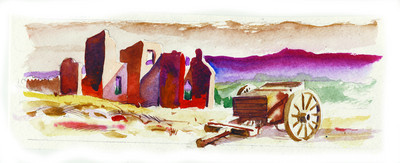Fort Churchill now peaceful but has seen share of strife in past
Stripped of roofs, windows and doors, stark adobe ruins remain of buildings that once comprised Nevada's first military installation. Strife between native Paiutes and white settlers in 1860 resulted in the establishment of Fort Churchill east of Carson City. Now preserved as Fort Churchill State Historic Park, the outpost saw nearly a decade of active use during turbulent times.
Fort Churchill lies about 390 miles from Las Vegas. Southern Nevadans traveling north on U.S. 95 toward Reno turn at Schurz onto Alternate U.S. 95 through Yerington to reach the park. Follow the short, paved park road leading to a visitor center near the ruins.
Visitors pay a $4 entrance fee at the visitor center, constructed in the 1930s by the Civilian Conservation Corps. Tour the center's indoor and outdoor exhibits for an introduction to the park. Use established trails to walk out among the stone foundations and ruined walls now kept in a state of arrested decay.
Picnic area, individual campsites and group camping areas lie at a little distance from the visitor center in the shade of trees and vegetation along the river. The tranquil stretch of water provides expanded recreational opportunities for wildlife watching, photography and river running by canoe, kayak or float.
The park anchors a complex of state-owned lands including historic Carson River ranches and the restored Buckland Ranch House, acquired in 1994. These form a corridor along the river connecting the fishing and boating popular at Lahontan Reservoir in Lahontan State Recreation Area.
Campers pay $12 per night for the Fort Churchill campsites and $10 per night to camp at the Carson River Ranches, all available without reservations. Make reservations for use of the group sites, popular with equestrians trail riding through the ranches and along the river. Fire restrictions now apply to these sites.
Constructed in 1870, the historic two-story Buckland Ranch House served as a pioneer family's home, hotel and way station for travelers for decades. Enterprising Samuel S. Buckland settled along the Carson River in 1859, where he set up a tent as a supply post and roadhouse serving emigrants on the overland trail. His first ranch house served as living quarters, trading post, tavern and hotel. He dug a canal to carry water to crops and livestock, built a toll bridge, and added wagon repair and blacksmith services. Buckland's place became a logical stop for the Pony Express riders to change horses and for stage lines to break their journey.
In May 1860, three men at Williams Station on the Overland Trail abducted and abused two Paiute girls. Native warriors retaliated by killing the men and burning the station before returning the girls to their people at Pyramid Lake. News of the violence angered settlers. A volunteer militia of 105 armed men assembled at Buckland's Station under the command of Major William Ormsby, a prominent Carson City resident.
Ormsby's little army marched off to strike at the Paiutes, directly into an ambush that killed two-thirds of the force, including Ormsby. The first battle of the Pyramid Lake War resulting in a disaster, the settlers called for federal protection. Troops arrived soon after from posts in California and the construction of fort Churchill began. The outpost played an important role as a recruitment center for Union troops during the Civil War, but had outlived its usefulness by 1869.
The Nevada Civil War Volunteers, a group of re-enactors from Reno, annually stage two encampments at Fort Churchill. On Memorial Day and the second weekend in October, their costumed activities bring the past to life.
Buckland prospered on brisk business with the fort and the soldiers stationed just a mile away. When the fort was decommissioned, Buckland bid $750 at auction for the fort's buildings. He stripped the site of salvage to build a fine new ranch house. The 1870 ranch house opened to visitors last year with several rooms decked out with antique furniture and period decor. Visiting the museum costs $1 for anyone over 12 years.
Margo Bartlett Pesek's column appears on Sundays.






















